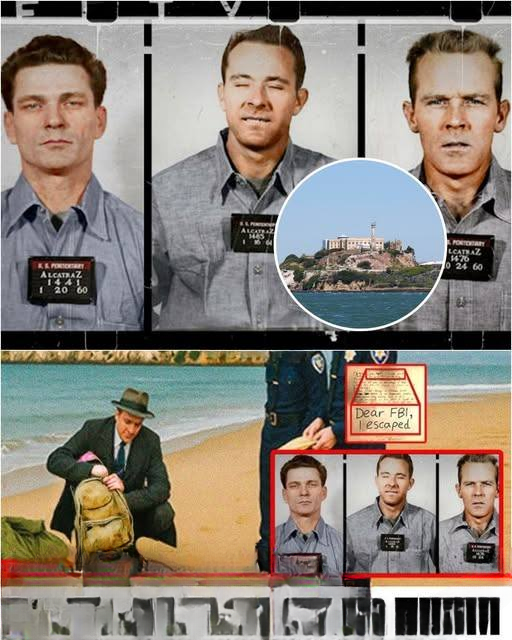Few stories in modern American history capture the imagination like the 1962 Alcatraz escape. Frank Morris and brothers John and Clarence Anglin defied what seemed impossible, vanishing from one of the most secure prisons ever built. Though authorities declared them dead in the icy waters of San Francisco Bay, decades of clues, letters, and eyewitness accounts continue to challenge history.
Their daring escape remains a testament to human ingenuity, courage, and the unrelenting desire for freedom. More than fifty years later, the legend of the men who “beat Alcatraz” continues to intrigue writers, historians, and true crime enthusiasts alike.
Alcatraz: The Rock That Broke Spirits
Alcatraz Island, rising from the foggy waters of San Francisco Bay, is a symbol of both fear and fascination. Originally a military fort, later a federal penitentiary, and now a museum, Alcatraz was designed to hold the nation’s most dangerous criminals. Its isolation, freezing waters, and strong tides made escape seem impossible.
From 1934 to 1963, Alcatraz housed notorious figures such as Al Capone, George “Machine Gun” Kelly, and Robert Stroud, the Birdman of Alcatraz. Prisoners spent up to 23 hours a day confined, with brief recreation periods and limited family contact. The prison’s strict rules and silent corridors reinforced the message: you can enter The Rock, but you will never leave it alive.
In nearly three decades, 36 men attempted to escape. Most were caught immediately or died in the attempt. Officially, none succeeded — until June 1962.
The Men Who Would Not Break
Frank Morris: The Mastermind
Frank Morris was far from a typical inmate. Highly intelligent and previously escaped from several prisons, Morris had scored in the top 2% on intelligence tests. Quiet and meticulous, he planned with patience, precision, and an unwavering determination to taste freedom. Authorities believed Alcatraz would contain him — but they underestimated his ingenuity.
John and Clarence Anglin: Brothers in Bravery
Raised in a large family in Georgia and Florida, the Anglin brothers were skilled laborers and bank robbers who shared a deep bond. For them, escaping Alcatraz was not only about freedom, but loyalty to each other. When they joined forces with Morris inside The Rock, they combined brains, skill, and courage to create one of the most famous escape plans in history.
Months of Preparation: Planning the Impossible
The escape wasn’t impulsive — it was a months-long operation. The trio identified a small ventilation shaft behind their cells leading to a utility corridor and eventually the roof. Using improvised tools made from spoons, machine parts, and scrap wood, they painstakingly widened the shaft over weeks, working silently at night.
To hide the sound of their work, they timed scraping and drilling to coincide with the prison band’s evening rehearsals. Painted cardboard covered the holes, perfectly camouflaging the widening vent openings.
The Ingenious Decoys: Dummy Heads
Knowing that a missing prisoner would trigger immediate alarm, the men created lifelike dummy heads. Soap, plaster, toilet paper, and stolen hair from the prison barbershop combined to fool the guards. During nightly bed checks, these decoys made the men appear asleep, allowing them to work undetected.
Raincoats, Rafts, and Ingenious Engineering
The next challenge was the water. San Francisco Bay is cold, swift, and dangerous — a mile-long swim could easily prove fatal. To survive, the trio crafted a makeshift raft and life vests from more than fifty prison-issued raincoats, carefully glued and sewn together. What seemed impossible became a calculated engineering project — a raft that could carry them to freedom.
June 11, 1962: The Night of the Escape
At nightfall, the men made their move. Quietly removing the vent covers, they climbed through the narrow service corridors and ascended to the roof. Using plumbing pipes, they descended the building’s back side and carried their raincoat raft to the water’s edge.
At around 10:00 p.m., Frank Morris and the Anglin brothers disappeared into the waves. The guards didn’t realize anything had happened until the next morning.
The Discovery and Panic on The Rock
The following morning, a guard checking the cells was shocked when a dummy head rolled off a pillow. Alarms blared, searchlights swept the island, and the greatest manhunt in Alcatraz history began.
Investigators found a makeshift raft and a few oars near Angel Island, along with some personal items. The FBI concluded that the men had likely drowned, though no bodies were ever recovered.
The Official Story vs. Ongoing Mystery
For 17 years, the FBI investigated every lead, from sightings in South America to anonymous letters. By 1979, the case was officially closed, with the escapees presumed dead.
Yet, evidence continued to surface:
- Letters allegedly from the Anglin brothers, received decades later.
- A 1975 photograph suggesting the brothers were alive in Brazil.
- Rumors in Rio de Janeiro of quiet American brothers living abroad.
Modern hydrodynamic simulations also suggested that if the men timed their entry into the water correctly, the currents could have carried them safely to Angel Island or Marin Headlands — raising the possibility that the escape was a remarkable triumph of planning and timing.
The Human Side of the Great Escape
This story isn’t just about engineering or criminal cunning. At its heart, it’s about the human desire for freedom.
Heart rate monitor
- Frank Morris sought dignity, independence, and a life free from the harsh confines of the prison system.
- The Anglin brothers were motivated by loyalty, survival, and the hope for a peaceful life beyond bars.
Their audacity highlights a universal truth: when humans are pushed to the edge, creativity, courage, and persistence can overcome almost any obstacle.
Legacy of the Alcatraz Escape
Today, Alcatraz is a museum attracting millions of visitors annually. Tour guides share the story of Morris and the Anglin brothers, encouraging guests to imagine the courage it took to dig through concrete with a spoon and craft a raft from raincoats.
The escape has inspired:
- Movies and documentaries.
- Books chronicling true crime and human ingenuity.
- Ongoing discussions about risk, planning, and perseverance.
Whether the men perished in the waters or lived under new identities, their story has become an enduring symbol of human ingenuity and the pursuit of freedom.
The Final Question: Did They Survive?
After more than sixty years, the question remains unanswered. Some believe the three men drowned in the cold Pacific. Others hold that they survived, living quietly under new names.
Regardless of the truth, the 1962 Alcatraz escape continues to captivate imaginations, illustrating that even the most secure walls cannot contain the human spirit forever.



